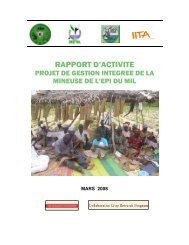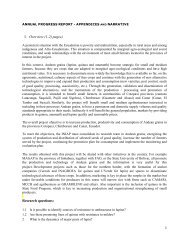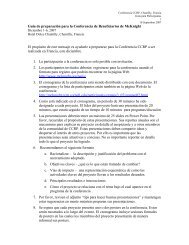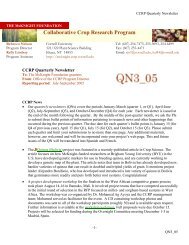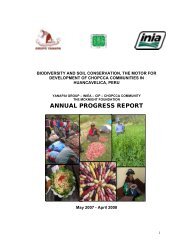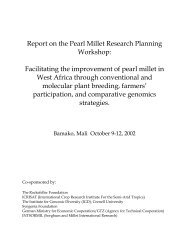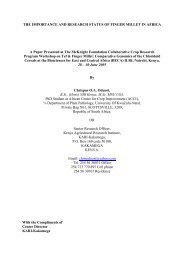English - McKnight Foundation Collaborative Crop Research Program
English - McKnight Foundation Collaborative Crop Research Program
English - McKnight Foundation Collaborative Crop Research Program
You also want an ePaper? Increase the reach of your titles
YUMPU automatically turns print PDFs into web optimized ePapers that Google loves.
<strong>McKnight</strong> <strong>Foundation</strong> <strong>Collaborative</strong> <strong>Crop</strong>s <strong>Research</strong> Project No: 06-741<br />
Development and promotion of Alectra resistant cowpea cultivars for<br />
smallholder farmers in Malawi and Tanzania<br />
Cowpea Utilization in Iringa and Dodoma Regions<br />
Peter S. Mamiro 1 , A. M. Mbwaga 2<br />
Introduction<br />
Mature dry cowpeas are important in the diets of many population groups around the<br />
world. Africa alone accounts for 7.5 million hectares of the estimated world total area, of<br />
about 10 million hectares. Of the 7.5 million hectares, about 70% lies in West and Central<br />
Africa (Singh et al., 1996). This food legume is readily available, inexpensive and<br />
popular part of the traditional food system. Cowpeas (Vigna unguiculata L.Walp) along<br />
with other legumes are recognized as an important source of protein (Agazounon et al,<br />
2004). However, their contribution to the overall diet and dietary mineral needs is less<br />
well known. For instance nutritional deficiencies of iron and zinc are often widespread in<br />
developing countries, where staple diets are frequently plant-based and consumption of<br />
expensive meat products is low. Cowpea is an annual legume, cultivated dried fresh grain<br />
and long stored dried grain being cooked while others are dehulled to remove the seed<br />
testa, then ground to obtain flour. The flour is used to make various dishes or recipes. The<br />
young and tender cowpea leaves are picked and eaten as relish along with the main<br />
staples. The grains and leaves are the source of carbohydrates, proteins, fats, vitamin A<br />
(ß-carotene), B and C, which are necessary for maintaining good health and fighting<br />
disease. Young cowpea leaves are consumed in at least 18 countries in Africa, and seven<br />
countries in Asia and the Pacific (Ahenkora et al., 1998). Cowpeas are among the top<br />
three or four leaf vegetables marketed and consumed (Barret, 1990). Cowpea also<br />
contains iron, calcium, phosphorus, magnesium, copper, zinc and is high in dietary fibre<br />
(Sinha and Kawatra, 2005). The other vegetative parts of the cowpea plant after removal<br />
of the grain, are used as feed, forage, hay and silage for livestock. This paper reports on<br />
the extent of utilization of cowpeas and its contribution to the macro and micro nutrients<br />
to communities that cultivate and consume the legume.<br />
Methodology<br />
Survey<br />
A survey to determine the pattern of utilization of cowpea was conducted in Iringa and<br />
Dodoma region in Kalenga and Msinga villages respectively. The choice of these villages<br />
was undertaken in collaboration with government extension authorities from the two<br />
regions. The communities are well known for the production, selling and consumption of<br />
cowpeas. The two regions fall within two different agro ecological zones,. Iringa being a<br />
wet region located in the southern highlands zone and Dodoma being a semi arid region<br />
in the central zone. A simple structured questionnaire seeking information on the quantity<br />
and frequency of consumption of cowpeas and other foods at the homestead was<br />
1<br />
1.Department of Food Science and Technology, Sokoine University of Agriculture, P. O. Box 3006,<br />
Morogoro, Tanzania.<br />
2 Uyole Agricultural <strong>Research</strong> Institute, Box 400, Mbeya, Tanzania



